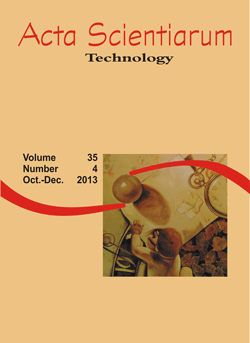<b>Structural features and inactivation of coagulation proteases of a sulfated polysaccharidic fraction from <i>Caulerpa cupressoides</i> var. <i>lycopodium</i> (Caulerpaceae, Chlorophyta)</b> - doi: 10.4025/actascitechnol.v35i4.16709
DOI:
https://doi.org/10.4025/actascitechnol.v35i4.16709Keywords:
Caulerpaceae, polysulfated, chemical analysis, coagulation, modulator actionAbstract
Studies on biopolymers from macroalgae suggested sulfated polysaccharides (SPs) as research agents to investigate events related to haemostasis. Caulerpa cupressoides var. lycopodium is a marine green alga containing three SPs fractions (SP1, SP2 and SP3). SP2 had anticoagulant (in vitro) and anti- and prothrombotic (in vivo) actions; however, its effect on the coagulation system is not fully understood. This study aimed to determine the infrared (IR) spectroscopy, chemical composition (CC), elemental microanalysis (EM), molecular weight (MW) and the effect on coagulation proteases of SP2. The presence of sulfate ester, galactose-6-sulfate, uronic acid and glycoside linkages for IR spectrum; contents of sulfate (28%), total sugars (40%) and uronic acids (7.18%) for CC; and content of carbon (21.98%), sulfate (4.27%), nitrogen (1.3%) and hydrogen (4.86%) for EM were obtained. The average molecular weights of four different SPs (SP-1, SP-2, SP-3 and SP-4) subfractions from the SP2 ranged from ~ 8 to >100 kDa. SP2 was tested on coagulation proteases (thrombin and factor Xa) in the presence of antithrombin (AT) and heparin cofactor II (HCII) using human plasma, being both thrombin and factor Xa target proteases inhibited, but requiring a concentration of about 2.5-fold higher of HCII than the thrombin inactivation by AT.
Â
Â
Downloads
Downloads
Published
How to Cite
Issue
Section
License
DECLARATION OF ORIGINALITY AND COPYRIGHTS
I Declare that current article is original and has not been submitted for publication, in part or in whole, to any other national or international journal.
The copyrights belong exclusively to the authors. Published content is licensed under Creative Commons Attribution 4.0 (CC BY 4.0) guidelines, which allows sharing (copy and distribution of the material in any medium or format) and adaptation (remix, transform, and build upon the material) for any purpose, even commercially, under the terms of attribution.
Read this link for further information on how to use CC BY 4.0 properly.











8.png)




